|
|

|
|
ADROMISCHUS MAMILLARIS Quest 2003
This
is a "very rare" plant in the wild and I have had trouble finding it.
The original specimen was collected "near***
Olifantsbad" by C.P. Thunberg. Perhaps this is the same as the
"Olyfant's hot bath" mentioned in his only book "Travels at the Cape of
Good Hope 1772-75", which he visited on 30th December 1773 with Masson.
Modern notes suggest that this is situated 4km east of the southern
entrance to Tooverwater/Toorwater Poort, E. of Oudtshoorn.
Tölken
(1985) gives the distribution for A. mamillaris
as "from the eastern parts of the Little Karoo, east of Calitzdorp, on
lower gravelly slopes". However, few Herbarium specimens exist and
Tölken cites only two vouchers. These have the imprecise locality of
"Calitzdorp". Only Liebenberg 6159 (illustrated on the previous web
page) has more precise directions: "W. Calitzdorp on the Ladismith
road". A search in a NW. direction up the Gamka River to Matjiesvlei in
1998 revealed only slightly narrower leaved, rosette-like forms of A.
triflorus.
The
Succulenta 2003 Convention in Sept./Oct. 2003 was held at the little
town of Calitzdorp and I took the opportunity to ask if locals had seen
Adromischus plants like A. mamillaris. Everyone
knew the abundant A. triflorus, but no-one
positively remembered seeing terete leaved plants resembling A.
mamillaris. Quick visits to the surrounding low lying areas
verified that only A. triflorus was present on
the shales and gravels.
By
the end of the Convention, the obvious place left to search was on the
big mountains directly W. of Calitzdorp. The Gamka River has carved a
deep gorge through the acidic sandstones of the Table Mountain Group,
Baviaanskloof and Skurweberg Formations. With Dr Peter Bruyns, we
climbed up to the steepest faces in a side gully.
Encountering
succulents for the first time is always the most enjoyable part of any
trip and this mountain provided several species new to me. Small bushes
with upright glaucous blue stems and leaves were Senecio
muirii. Untidy, fat-stemmed bushes with tufted, cylindrical
leaves at the ends were probably S. ficoides. A
still unidentified Crassula and a patch of the
lovely orange bulb, Tritonia watermeyteri, also kept
me busy with the camera. Then Peter called me up to see a rare
Stapeliad: stems of Tromotriche choanantha were
looping downwards - growing into darker places to root and shoot
outwards again. Numerous other succulents were noted.
What
about the Adromischus? Even at relatively low levels on the
mountainside, the A. triflorus plants had
elongated, decumbent stems. As we climbed higher, the leaves became
narrower and the terminal horny margin less broad. I never made it to
the top that afternoon, but a cutting Peter brought down was a good
match for A. mamillaris. He also found a
relatively broad-leaved form of Haworthia blackburniae.
Tölken
(1985) states the A. mamillaris is "a very rare
species which is not considered to be merely a narrow-leaved form of
the variable A. triflorus as it does not produce
the typical curved buds". However, the voucher Herre in SUG 5403 (BOL!)
does have curved buds and in my experience, curved flower buds are not
always present in the widespread A. triflorus.
Thus, if Liebenberg 6159 is indeed A. mamillaris,
there is little reason to keep it as separate species. However, the
type specimen needs to be checked, since it is worrying that A.
inamoenus does have straight buds.
|
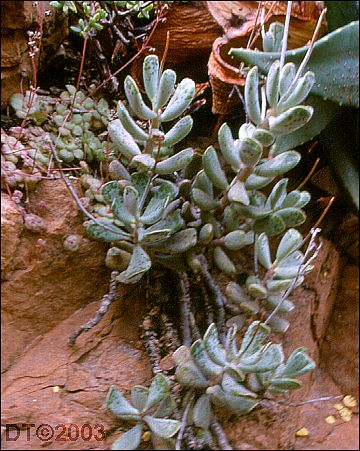
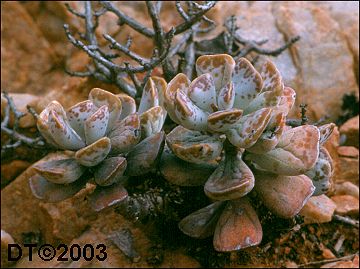
A. mamillaris/triflorus intermediates,
W. Calitzdorp.
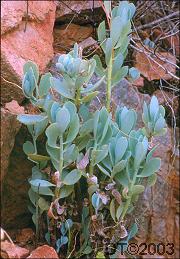 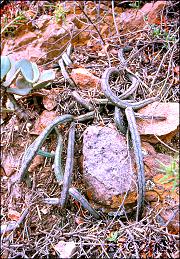
Left:Senecio
muirii, Right:Tromotriche choanantha
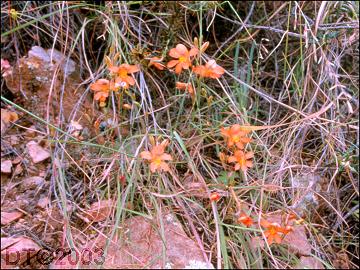
Tritonia
watermeyeri
|
|
*** Thunberg & Masson's
Perilous Visit to Calitzdorp
"Near"
is a shorter distance nowadays than in the eighteenth century! Few
places in South Africa had names then. Four days after visiting the
Olyfant's hot bath, Thunberg reported the following adventure, which
probably took him into what is now the Calitzdorp area. I wonder if
this is actually when he collected his A. mamillaris
specimen?
Peter
& I easily drove back to a hotel for the night. Travelling was
not so easy in 1773 ...
"We let
our [waggon] drivers and Hottentots go on with the vehicles through
Hartequas [Attaquas] Kloof ...; and I, with my English fellow-traveller
[Masson], determined to go on horseback over the dry Carro, which lay
to the right, and afterwards proceed through Platte Kloof. But this
expedition did not end very fortunately; for, as in this level plain
which is seldom visited by travellers, there were no tracks to follow,
we missed our road, and the longer we travelled the farther we went
astray, so that at last we could not even find our way back again. We
rode on however, as fast as our horses could go, and the sun began to
go down without our having perceived the least trace of a house or
farm. At length the sun being set, and no hopes left, we retired a
little way back to a valley, where there was a small brook, with a few
trees on its borders; and in this brook, there was still some water."
|

Inside the sandstone gorge.
|
|
"Here we
thought it advisable to take up our lodging for the night. Accordingly
we unsaddled our horses, and tied them up, with the halter round one of
their legs, that they should not run away; and then, by means of our
guns, we made a large fire of canna bushes (Salsola
aphylla). After this, we lay
down near the fire, with the saddles under our heads; but could not get
a wink of sleep, on account of an intolerable sensation of cold, which,
though not so very intense in itself, yet, by reason of the burning
heat we had endured in the daytime, was severely felt by us, and forced
us to rise several times in the course of an hour, in order to mend the
fire, and warm ourselves all over. We had derived this advantage from
our guns, that we could always make a fire; but we had no hopes of
finding any thing in this plain to shoot, by which we might satisfy the
cravings of our stomachs. I had therefore taken the precaution to put
into my shooting-bag a few biscuits and pieces of sugar-candy, which
were extremely welcome to us at this juncture."
"As soon
as it was morning, we looked about us for our horses, but found that
they were vanished, which did not a little add to our concern, situated
as we were in a desart, where our fate was uncertain. After having
searched the valley all around, we went up upon the heights, and behind
these we at last found our horses, which without doubt were upon the
point of going farther, to look out for better fodder. Having saddled
them, we directed our course obliquely towards the mountains, where we
arrived towards evening, at the house of a farmer, who was so poor as
scarcely to be master of any thing more than the roof over his head.
Here we took up our night's lodging, and afterwards made our way to
Hartequas Kloof, where we met with our people and our vehicles."
The
Scot, Francis Masson's account of this incident (both written up years
later) is scarcely recognisable as the same:
"We again
parted with our waggons, in order to examine a large tract of Carro,
where it was improper to take our oxen on account of the scarcity of
water. Late in the afternoon we came to a peasant's house, who informed
us, he had a neighbour about four hours ride from his place, by whom we
should be kindly received, and who would further direct us on our
journey. After having put us in the road, and given us some directions,
he parted with us, and we pursued our journey till sun-set, but found
no habitation. We therefore concluded, that we had certainly lost our
way, and returned some miles back, where we found a road which branched
off another way. In this path we continued till one o'clock in the
morning, having got into a dismal valley, inclosed on each side with
rugged precipices: at last we found ourselves in the middle of a
thicket of thorn trees (Mimosa
nilotica) where we unsaddled
our horses and kindled a fire. We passed the night with little comfort,
having eaten nothing all that day; but to our great satisfaction we
heard the murmuring of a stream, which we went in search of, and found
good water: our concern, however, was still great for our poor horses
that had nothing to eat. We spent the night in gathering wood and
keeping our fire up till day-light, when I climbed up a high precipice,
and viewed the country. Here I collected several curious plants (Geranium
spinosum, Stapelia
euphorbioides); and upon my
return, we mounted our horses, and directed our course towards the high
mountains, where we expected to find some relief, but were
disappointed; for after being parched up with insupportable heat, we
met not with a drop of water to quench our thirst during the whole
day's journey. But towards the evening we happily discovered a house,
where we were kindly entertained, and the next morning overtook our
waggons in Hartwig's [Attaquas] Kloof, but our oxen were in a bad
state, and one of them was quite unfit for service."
Some
correspondence between Masson and Banks is available on-line from the State Library of New South Wales.
|
|

View to NE: the Gamka
River and Calitzdorp are visible. A major fault line running E-W. can
clearly be seen with darker, older rocks beyond, including the
Swartberg in the far distance.
|
|
Last Updated: Mar 2004 |
 |
© 2004 Derek Tribble, London, UK |
|
|